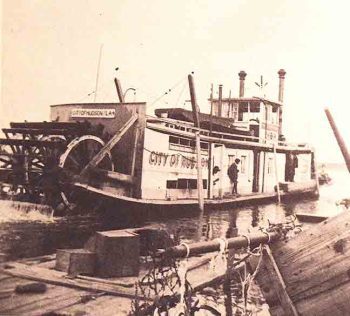
First of a series
The Mississippi River and other navigable streams were the superhighways of the 1800s when the nation expanded west. After settlements had been established (five along the Mississippi in what became Houston County), all sorts of watercraft were used to cross the river back and forth, including canoes, poleboats, rowboats, excursion boats, show boats, steamboats, pleasure boats and tug boats pushing barges.
Rafts were crude vessels that brought many settlers and all their worldly goods to the frontier. They continued to provide transportation up, down and across the Mississippi for many years.
Two government boats, the “General Allen” and the “Fury” worked on the river building the first wing dams. However, private enterprise was most often involved.
Steam-powered packet boats operated on a regular basis on fixed routes to carry mail, passengers and goods. The “Vigor,” the “White Beaver,” the “Badger” and the “City of Hudson” were daily packet boats that traveled between Brownsville and Winona in Minnesota and La Crosse, Wis., and Lansing, Iowa. One could travel from Brownsville for a day of activity in La Crosse by boarding for a fee of 50 cents. If something was taken to sell in La Crosse, there would be a small freight charge. If you returned with a purchase of anything of any size, there would be a freight fee as well. If it could be brought aboard, it qualified – grain, wood, cows. Between Brownsville and La Crosse, it was a 45-minute voyage one way.

Photo courtesy of the Houston County Historical Society
Those commercial goods also needed to cross the river during winter when the river was covered with ice. That was accomplished with teams of horses and sleds. Sometimes, as many as 50 teams and sleighs comprised a long procession crossing the Great Father of Waters.
Show boats, with performers living on board, were floating theaters that brought dramatic and musical entertainment to small towns on American rivers from the 1870s to the 1930s. According to Carol Walhovd and Fern Heiller of Brownsville, the Cotton Blossom Show Boat was the most popular vessel on the river. “People waited for its coming with great anticipation. There were play acting shows, dancing and much music. It was all very exciting and colorful and something to remember for a long time after. On these boats, you could even have your photograph taken. It was called the floating gallery.”
It was common to see the “North Star,” a pleasure boat belonging to the famous Mayo brothers of Rochester, cruising near Brownsville during the summer. The “Capitol” was an excursion vessel that left La Crosse and traveled to Winona, then back to La Crosse and on to Brownsville and Lansing, Iowa, before heading back to La Crosse – picking up passengers all along the voyage.
The sight of tug boats pushing barges has been an enduring experience for those living along the river. “It is something we all look forward to,” Heiller and Walhovd recalled in 1976. “To see the first barges come up the river after a long winter makes us feel spring is here. These boats bring out the romance of our little river town with all their pretty lights and slow-moving grace. When the ice breaker comes through, word travels ahead and many people go to the banks of the river and watching it with a loving eye.”
There was danger on the river, sometimes resulting in loss of life, watercraft and cargo. The “Bella Mae” was completely destroyed when its boiler exploded on the channel in front of upper Brownsville. Many people perished, but not all. During subsequent summers on nearby sandbars, people would pick up items from the “Bella Mae.”
A boat carrying a cargo of cannon balls for the Civil War sank in Raft Channel south of Brownsville. When the river was low, the top of the pilot house could be seen sticking up above the surface of the water.
Travel across the river ice was especially perilous late in the season. Wagons, horses, men and even automobiles were known to fall through the ice. Some, including Mike Mullen in 1917, attempted to cross on foot, got lost in a snowstorm and froze to death.
The river was a source of income for many, to be continued.
Source: The Brownsville Story (1976), compiled and edited by Carol Walhovd and Fern Heiller


Leave a Reply